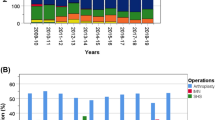Abstract
The hip fracture audit in Nottingham started in May 1999. Using our data, we have developed the Nottingham Hip Fracture score and are able to predict long-term survival. High quality data collection is best achieved by trained staff dedicated to data collection and analysis. We have found it very cost-effective to train audit clerks in basic data analysis and statistical techniques, allowing for rapid analysis of data. We have developed a pre-operative scoring system to predict 30-day mortality for patients undergoing hip fracture surgery and the score is calculated for all patients over 65 years. In 2008, our audit data were used to assess mortality associated with hip fractures in the geriatric population at 5 years, and to identify the influence of pre-operative age, cognitive state, mobility and residential status on long-term survival. This study allows us to identify patients with a higher chance of long-term survival and consider surgical management that may provide a better long-term outcome. The prevalence of hip fracture in our population has steadily increased over the past decade and we are able to report a fall in the 30-day mortality and the 1-year mortality with time. Using the Nottingham Hip Fracture score which identifies patients pre-operatively that are at high risk of mortality has proved extremely useful in clinical practise. The United Kingdom National Hip Fracture Database was established in 2007 to improve the quality and cost-effectiveness of care for hip fracture patients. Variation in quality of care should be reduced between units and best practise adopted throughout the health service.




Similar content being viewed by others
References
Kinn S, Lee N, Millman A (1995) ABC of medical computing: using computers in clinical audit. BMJ 311:739–742
Lord J, Littlejohns P (1997) Evaluating healthcare policies: the case of clinical audit. BMJ 315:668–671
Currie CT, Hutchison JD (2005) Audit, guidelines and standards: clinical governance for hip fracture care in Scotland. Disabil Rehabil 15(27):1099–105
The Scottish Hip Fracture Audit. Available from www.shfa.scot.nhs.uk
Boulton C, Morris C, Moran CG. Hip Fracture Audit, 10 year review 1999–2009, available from authors, Queens Medical Centre Nottingham
Maxwell MJ, Moran CG, Moppett IK (2008) Development and validation of a preoperative scoring system to predict 30 day mortality in patients undergoing hip fracture surgery. Br J Anaesth 101(4):511–7
Haentjens P et al (2010) Meta-analysis: excess mortality after hip fracture among older women and men. Ann Intern Med 152(6):380–90
Pedersen SJ et al (2008) A comprehensive hip fracture program reduces complication rates and mortality. J Am Geriatr Soc 56(10):1831–8
Vidán M, Serra JA, Moreno C, Riquelme G, Ortiz J (2005) Efficacy of a comprehensive geriatric intervention in older patients hospitalized for hip fracture: a randomized, controlled trial. J Am Geriatr Soc 53(9):1476–82
Shiga T, Wajima Z, Ohe Y (2008) Is operative delay associated with increased mortality of hip fracture patients? Systematic review, meta-analysis, and meta-regression. Can J Anaesth 55(3):146–54
Moran CG, Wenn RT, Sikand M, Taylor AM (2005) Early mortality after hip fracture: is delay before surgery important? J Bone Joint Surg Am 87(3):483–9
Stewart N, Moran CG, Boulton C. Predictors of 5 year survival following hip fracture 2009, available from authors, Queens Medical Centre Nottingham
The National Hip Fracture Database. Available from www.nhfd.co.uk
British Orthopaedic Association (BOA) (2007) The care of patients with fragility fracture. (also known as the Blue Book). Available from www.nhfd.co.uk
Dixon J (2004) Payment by results—new financial flows in the NHS. BMJ 328:969–970
Acknowledgment
The hip fracture audit in Nottingham is funded by Nottingham University Hospital NHS Trust.
Conflict of interest
None.
Author information
Authors and Affiliations
Corresponding author
Appendix
Appendix

Rights and permissions
About this article
Cite this article
Gunasekera, N., Boulton, C., Morris, C. et al. Hip fracture audit: the Nottingham experience. Osteoporos Int 21 (Suppl 4), 647–653 (2010). https://doi.org/10.1007/s00198-010-1426-8
Received:
Accepted:
Published:
Issue Date:
DOI: https://doi.org/10.1007/s00198-010-1426-8




